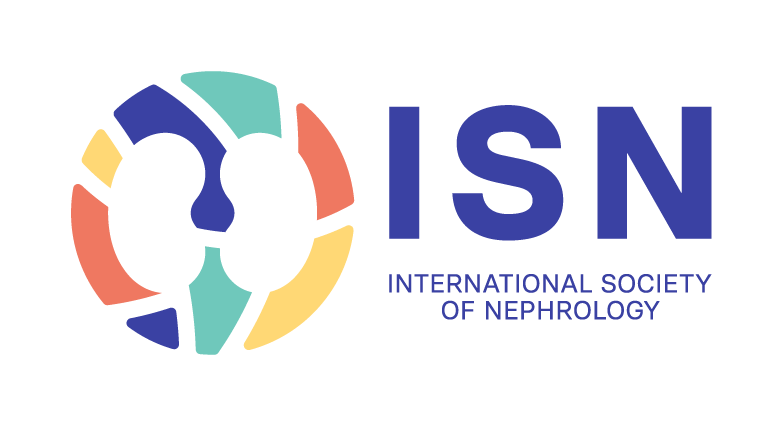Mar 2025 Edition

Impact Factor 2023
New Understandings in Nephropathy & Glomerular Disease
This eDigest highlights recent advances in nephropathy and glomerular diseases from Kidney International ® (KI) and Kidney International Reports® (KIR).
- KI articles explore advances in understanding autoimmune-related nephropathy, including novel diagnostic approaches and targeted therapeutic strategies.
- KIR articles discuss the complexities of glomerular disease progression, including environmental factors, the long-term effects of therapies like rituximab, and emerging risks to kidney function.

KIDNEY INTERNATIONAL ARTICLES |
Anti-nephrin Autoantibodies in Steroid-resistant Nephrotic Syndrome May Inform Treatment Strategy
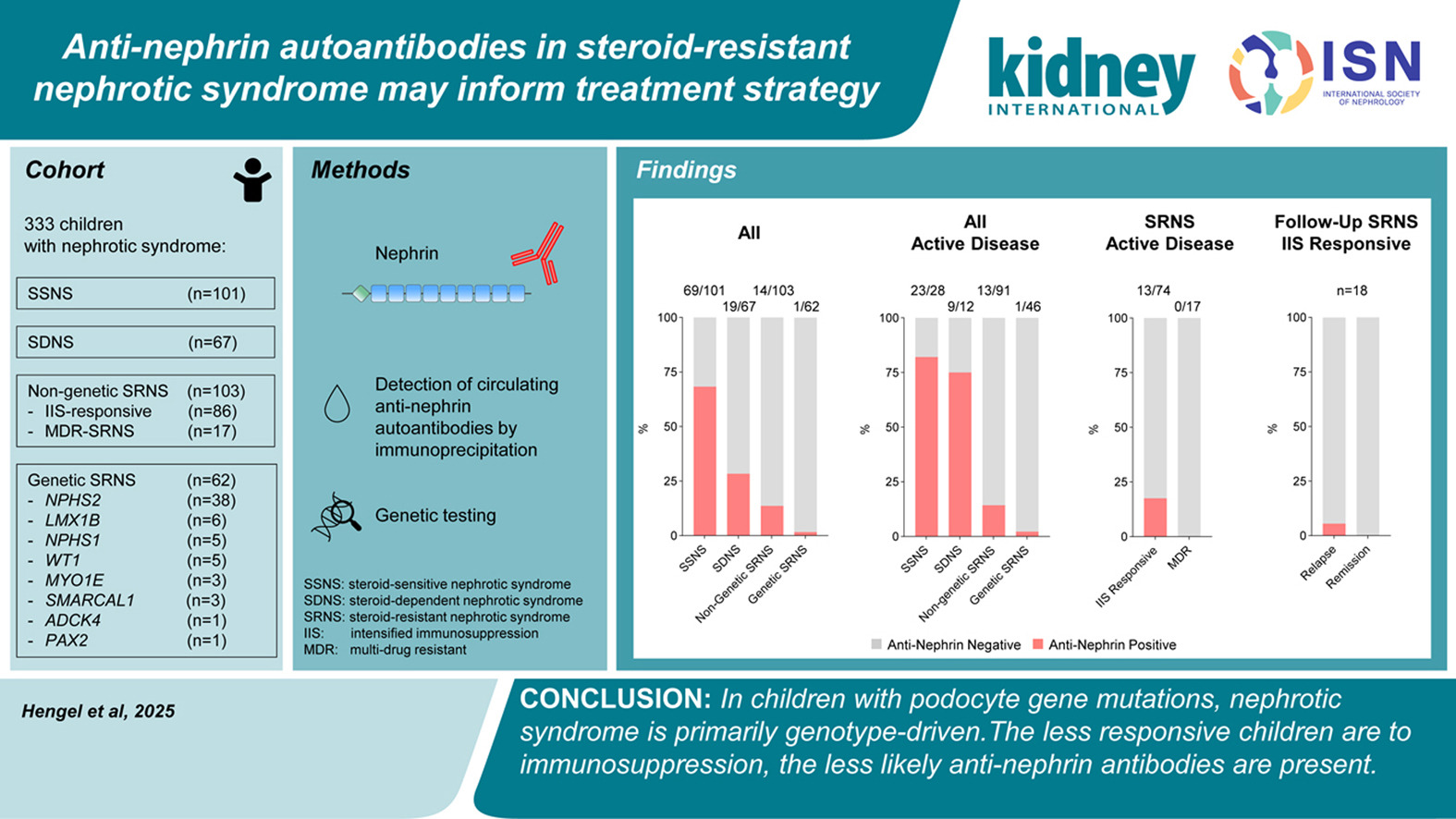
The discovery of anti-nephrin autoantibodies in steroid-resistant nephrotic syndrome (SRNS) highlights an autoimmune component in its pathogenesis, offering new treatment opportunities. Immunosuppressive therapies like rituximab or cyclophosphamide, along with plasmapheresis or immunoadsorption, may improve outcomes by targeting these antibodies.
Beyond treatment, these autoantibodies could serve as biomarkers for predicting prognosis and guiding therapy. Their identification moves SRNS management toward personalized medicine, though further research is needed to refine targeted strategies.
A Kidney Organoid-based Readout to Assess Disease Activity in Primary and Recurrent Focal Segmental Glomerulosclerosis

The pathogenesis of primary focal segmental glomerulosclerosis (pFSGS) remains unclear, and there are currently no diagnostic tools to predict disease recurrence after kidney transplantation. The lack of suitable models for studying FSGS has hindered progress in this field. In this study, the authors hypothesized that kidney organoids could serve as a high-throughput platform to detect pathogenic factors in plasma from patients with native pFSGS (npFSGS) and recurrent pFSGS post-transplant.
Organoids exposed to plasma from patients with recurrent pFSGS developed podocytopathy, extracellular matrix accumulation, fibrosis, and apoptosis, whereas plasma from non-recurrent FSGS patients and healthy controls had no detrimental effect. Furthermore, pFSGS plasma disrupted podocyte-specific protein expression (nephrin and podocin) and induced cytokines associated with inflammation and angiogenesis. Interestingly, plasma collected after therapeutic plasma exchange in a recurrent pFSGS patient caused less apoptosis in organoids, suggesting a reduction of circulating pathogenic factors.
This innovative model highlights the potential use of kidney organoids as a functional assay to identify plasma-derived factors driving FSGS and opens avenues for predicting disease recurrence before transplantation.
An International, Multi-center Study Evaluated Rituximab Therapy in Childhood Steroid-resistant Nephrotic Syndrome
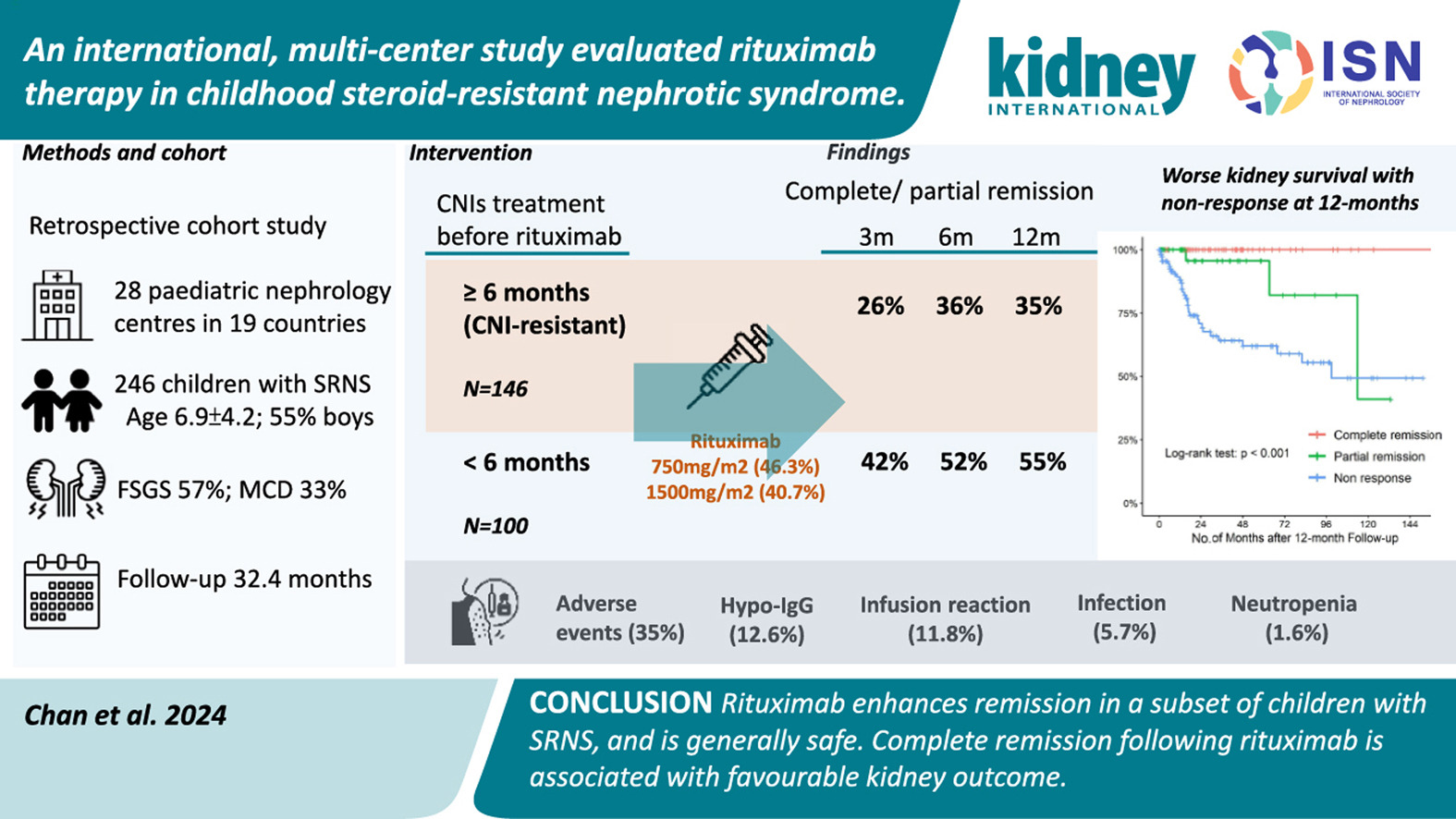
This global study assessed the effectiveness and safety of rituximab in 246 children with steroid-resistant nephrotic syndrome across 28 pediatric nephrology centers in 19 countries. Findings revealed that children who received rituximab after less than six months of prior calcineurin inhibitor (CNI) treatment had higher remission rates (55% at 12 months) compared to those with longer CNI exposure (35% at 12 months). Importantly, non-responders faced a greater risk of kidney failure.
While approximately 30% of participants experienced adverse events, these were generally mild and manageable. The study suggests that rituximab may be beneficial, particularly for children with a shorter duration of prior CNI therapy, though its overall efficacy remains variable. Achieving complete remission was linked to better long-term kidney outcomes. Further research is needed to identify predictors of response and ensure safe monitoring for potential side effects, such as infections and low immunoglobulin levels.
This study provides valuable insights into rituximab’s role in managing this complex kidney condition.
A Reliable Clinical Test for Detection of Membranous Nephropathy Antigens Using Laser Microdissection and Mass Spectrometry
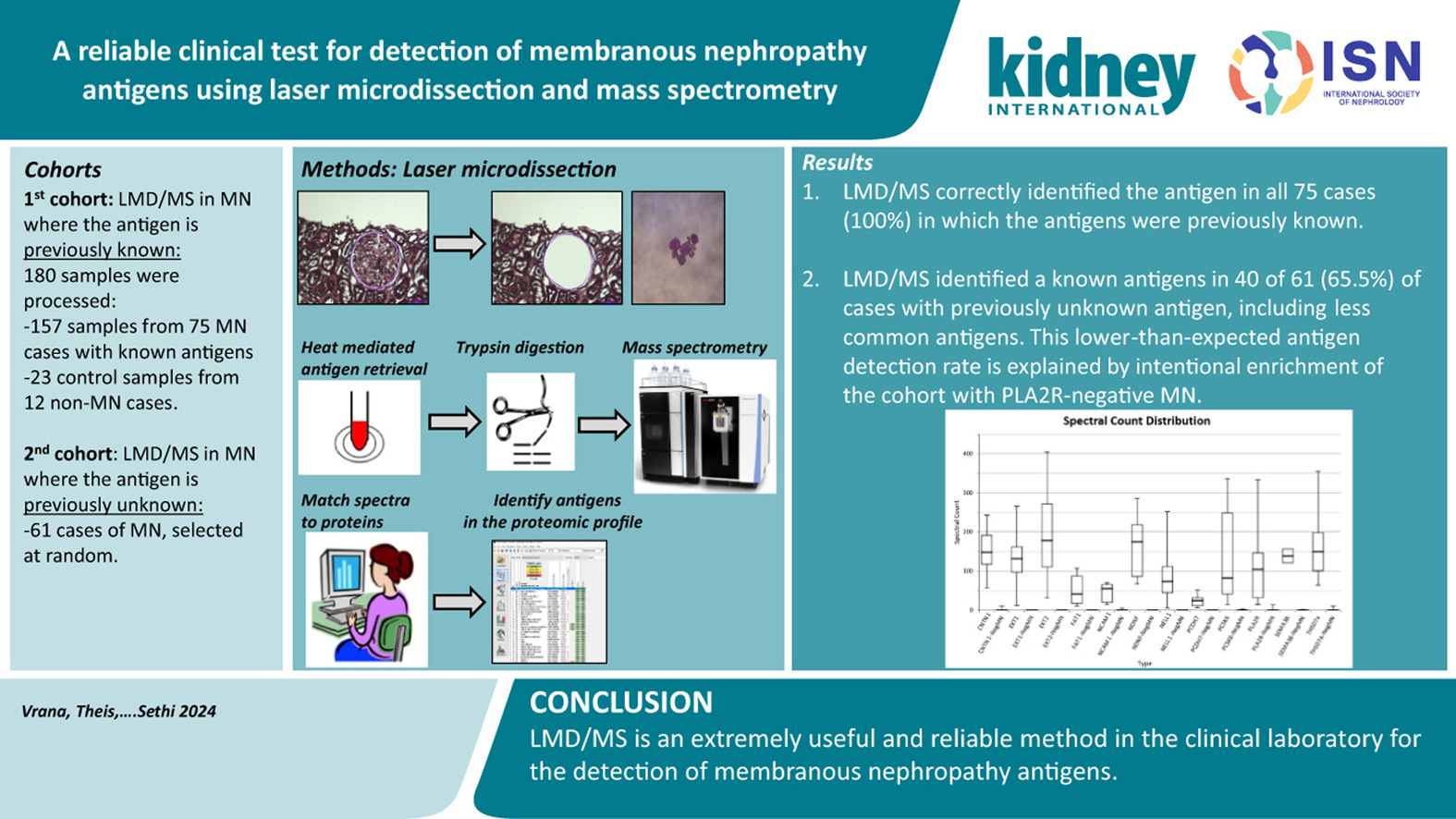
Membranous nephropathy (MN) is a leading cause of nephrotic syndrome in adults, characterized by immune complex deposition along the subepithelial region of the glomerular capillary walls. Over the past 15 years, at least 13 target antigens have been identified in MN, including common ones like PLA2R, NELL1, and EXT1/EXT2, as well as rarer antigens such as THSD7A, SEMA3B, and NCAM1. Identifying these antigens has critical diagnostic, prognostic, and therapeutic implications. While immunohistochemistry and immunofluorescence are routinely used to detect common MN antigens, their application is limited when dealing with rare antigens due to the lack of specific antibodies and technical challenges. The article presents a novel, validated clinical test based on laser microdissection and mass spectrometry that enables the identification of both common and rare MN antigens directly from kidney biopsy tissue.
This approach represents a significant advancement in precision medicine for MN, offering a comprehensive diagnostic tool that can guide more targeted therapeutic strategies. The ability to detect uncommon antigens could be crucial for patients who are negative for PLA2R and other commonly tested markers, potentially leading to more personalized management. Future directions will need to focus on the broader clinical implementation of this technique and the standardization of protocols for routine clinical use.
Treatment of Patients with IgA Nephropathy: A Call for a New Paradigm
IgA nephropathy (IgAN) is the most common primary glomerulonephritis worldwide and a leading cause of chronic kidney disease. Although supportive care — based on renin–angiotensin–aldosterone system blockade, blood pressure control, and lifestyle modifications — remains fundamental, a significant proportion of patients continue to progress to kidney failure. The use of corticosteroids has shown benefits in reducing proteinuria but is associated with substantial adverse effects, limiting their widespread use.
Recent advances have introduced novel targeted therapies that may redefine IgAN management. SGLT2 inhibitors have demonstrated renoprotective effects, including reduced proteinuria and slower estimated glomerular filtration rate decline.
Sparsentan significantly lowered proteinuria compared to irbesartan in the PROTECT trial. Additionally, Nefecon, a targeted-release budesonide, and iptacopan, a complement pathway inhibitor, have shown promising results in reducing proteinuria and preserving kidney function. These emerging therapies support a shift toward targeted, safer, and more effective interventions in IgAN beyond traditional immunosuppression.
KIDNEY INTERNATIONAL REPORTS ARTICLES |
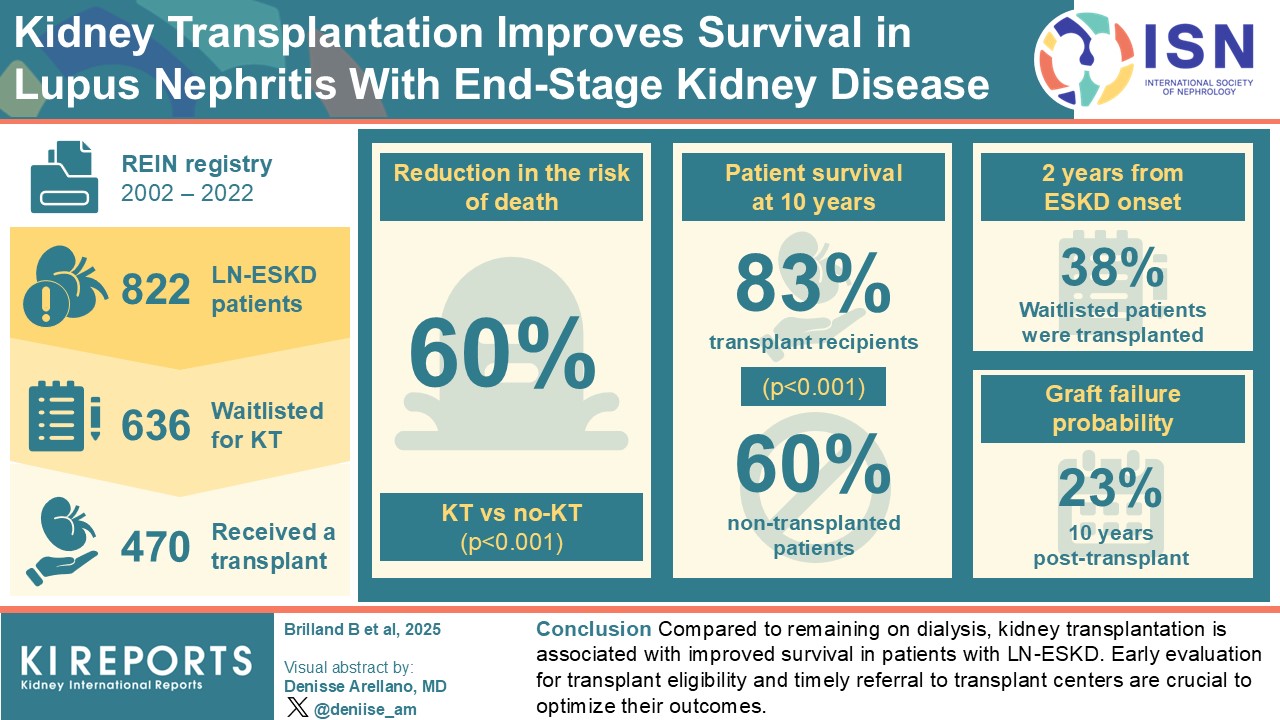 For patients with antineutrophil cytoplasmic antibody-associated vasculitis and end-stage kidney disease, kidney transplantation significantly improves survival and quality of life compared to dialysis, potentially reducing cardiovascular complications. Despite these benefits, careful post-transplant monitoring is essential to prevent relapse and graft loss.
For patients with antineutrophil cytoplasmic antibody-associated vasculitis and end-stage kidney disease, kidney transplantation significantly improves survival and quality of life compared to dialysis, potentially reducing cardiovascular complications. Despite these benefits, careful post-transplant monitoring is essential to prevent relapse and graft loss.
This study reinforces the life-saving role of transplantation in this population. Optimizing long-term success requires individualized care and evolving protocols to address the unique challenges these patients face.
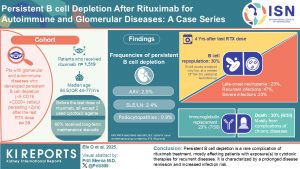 This retrospective case series describes persistent B cell depletion (<5 CD19+CD20+ cells/μL lasting >2 years) following rituximab (RTX) therapy in patients with autoimmune and glomerular diseases. Among 1,519 RTX-treated patients, 2% (n=30) developed this rare complication. RTX was used for a range of indications, including antineutrophil cytoplasmic antibody-associated (ANCA) vasculitis, systemic lupus erythematosus, podocytopathies, ANCA-negative vasculitis, anti-GBM disease, Behçet’s disease, and polymyositis. Most patients had prior prolonged exposure to cytotoxic agents and maintenance steroids.
This retrospective case series describes persistent B cell depletion (<5 CD19+CD20+ cells/μL lasting >2 years) following rituximab (RTX) therapy in patients with autoimmune and glomerular diseases. Among 1,519 RTX-treated patients, 2% (n=30) developed this rare complication. RTX was used for a range of indications, including antineutrophil cytoplasmic antibody-associated (ANCA) vasculitis, systemic lupus erythematosus, podocytopathies, ANCA-negative vasculitis, anti-GBM disease, Behçet’s disease, and polymyositis. Most patients had prior prolonged exposure to cytotoxic agents and maintenance steroids.
B cell repopulation was limited — only 30% showed partial recovery at 4 years post-RTX, and counts remained low. Notably, 83% achieved sustained remission, but infections (late-onset neutropenia, recurrent, and severe infections) were common; nearly one-third of patients died, mainly due to chronic disease complications, and about one-fourth required immunoglobulin replacement.
This study underscores that persistent B cell depletion is an uncommon but serious adverse effect of RTX, especially in heavily immunosuppressed patients, and, while associated with disease remission, it poses a significant risk for infections and long-term complications.
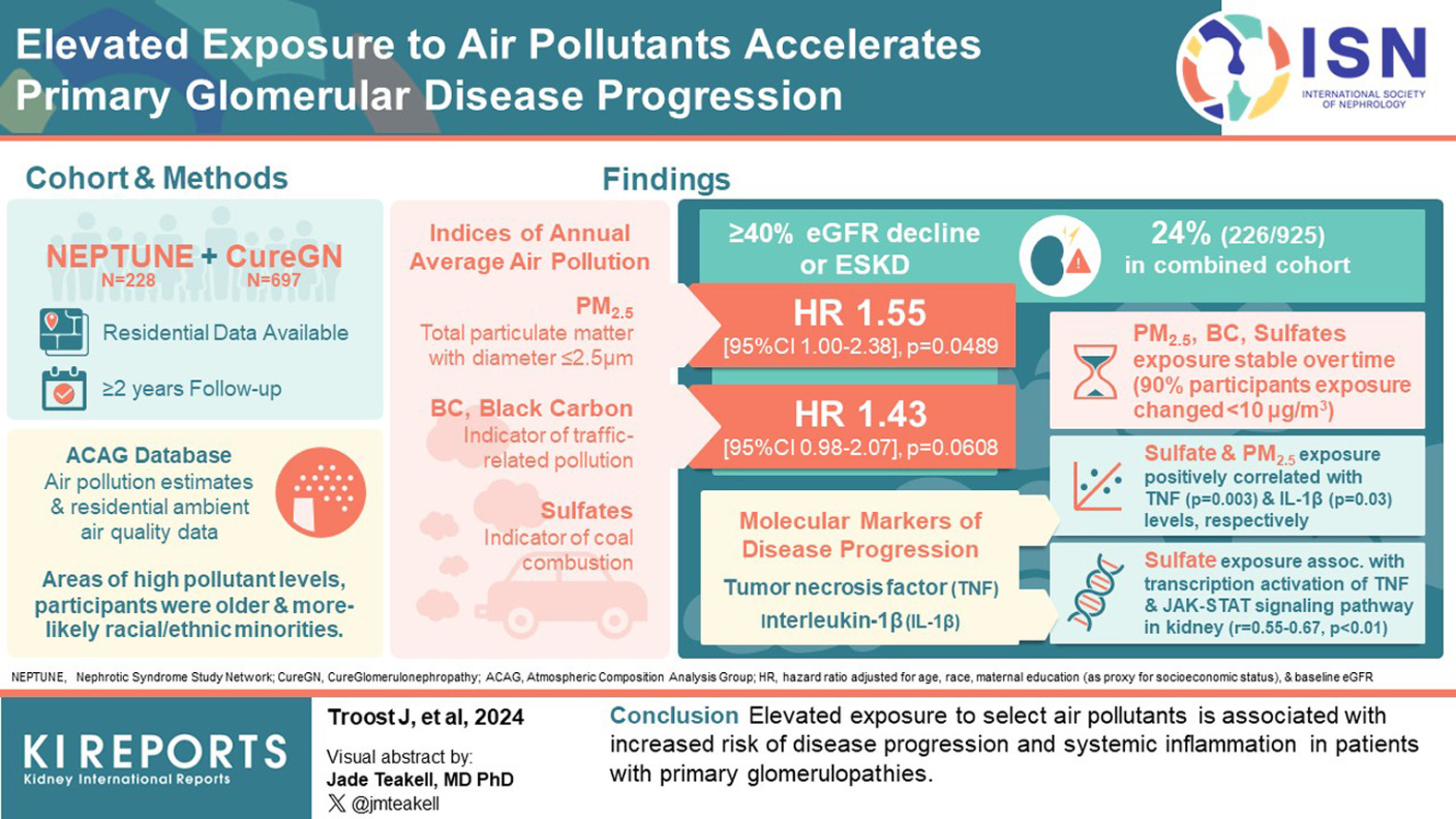
This study examines the impact of ambient air pollution on the progression of primary glomerular diseases, leveraging data from the NEPTUNE and CureGN cohorts.
Researchers found that higher exposure to fine particulate matter and black carbon was significantly associated with accelerated kidney function decline, with hazard ratios of 1.55 (p=0.0489) and 1.43 (p=0.0608), respectively. Sulfate exposure was linked to increased systemic inflammation, including elevated tumor necrosis factor
(TNF) and interleukin-1β, as well as activation of pro-inflammatory pathways in renal tissue, particularly JAK-STAT and TNF signaling.
These findings underscore the role of environmental exposures in glomerular disease progression and position air pollution as a modifiable risk factor. Notably, patients with greater pollutant exposure had lower baseline estimated glomerular filtration rates and were more likely to belong to racial and ethnic minority groups — populations already at higher risk for adverse kidney outcomes. Importantly, the associations were observed even at pollutant levels below current U.S. Environmental Protection Agency thresholds, suggesting potential nephrotoxicity at lower exposures than previously recognized.
For nephrologists, these results highlight the need to consider environmental risk factors in patient assessment and disease management. Further research should explore targeted interventions, including air filtration and policy changes, to mitigate pollution-related kidney damage.
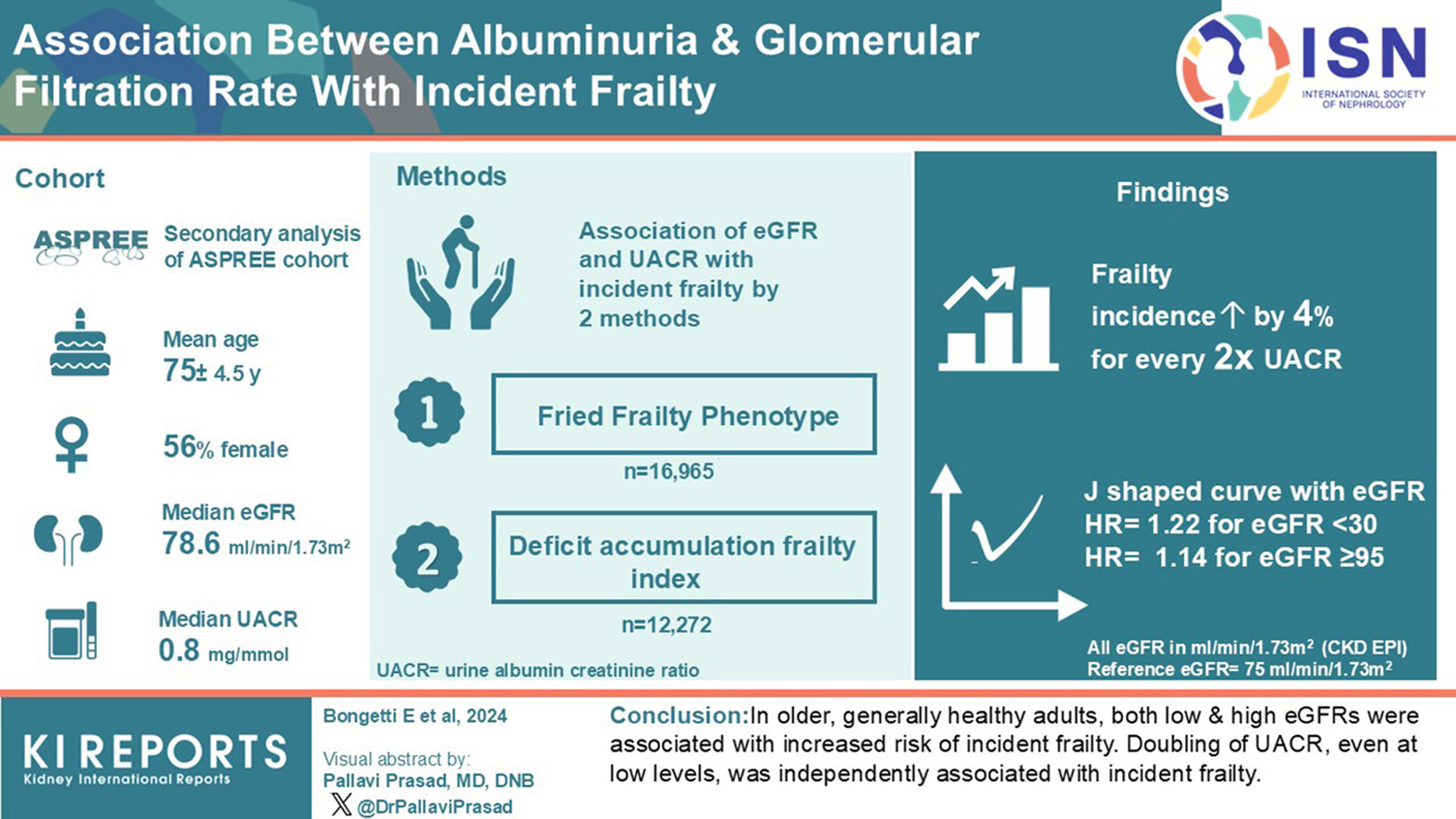
The relationship between kidney function and frailty in older adults is an emerging area of interest with important implications for preventive care. This secondary analysis of the ASPREE (ASPirin in Reducing Events in the Elderly) trial investigates whether baseline estimated glomerular filtration rate (eGFR) and urine albumin-to-creatinine ratio (UACR) are associated with the development of frailty in an otherwise healthy elderly population.
The study found a non-linear association between eGFR and incident frailty, with both low (<30 ml/min/1.73 m²) and high (>95 ml/min/1.73 m²) eGFR levels linked to increased risk of frailty. Moreover, each doubling of UACR was independently associated with a 4% increased risk of frailty, even at low levels of albuminuria.
These findings suggest that markers of kidney function, including mild albuminuria, may serve as early indicators of frailty risk, highlighting the importance of kidney health monitoring in older adults. From a clinical perspective, incorporating eGFR and UACR assessments into routine evaluations of elderly patients could help identify those at greater risk of frailty, enabling earlier interventions aimed at preserving functional status and quality of life.
Future studies are warranted to explore whether targeted interventions to reduce albuminuria or maintain optimal kidney function could mitigate the risk of frailty progression in this population.
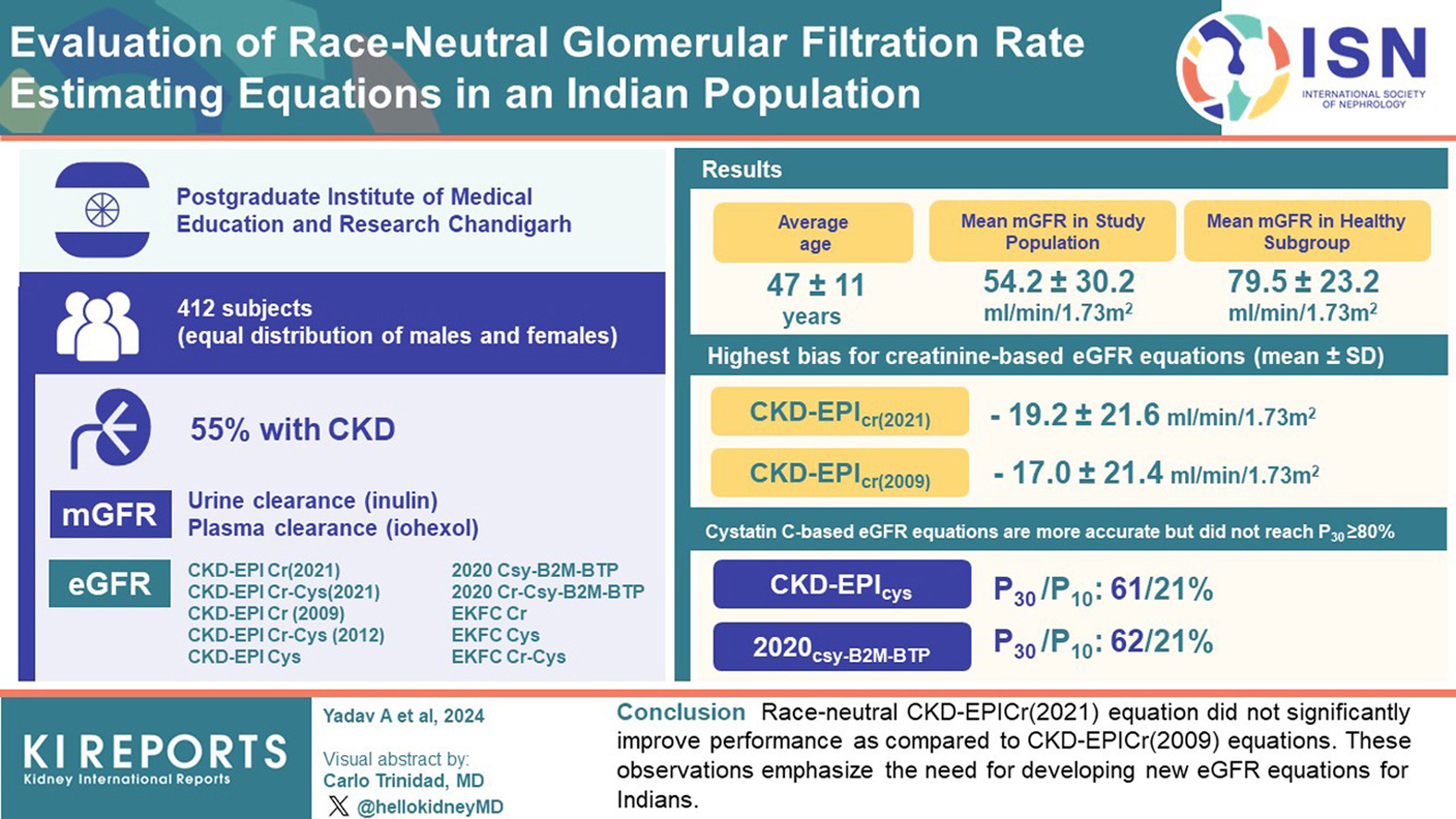
The accuracy of glomerular filtration rate (GFR) estimating equations remains a critical issue in diverse populations. Prior studies have demonstrated that the creatinine-based CKD-EPI 2009 equation tends to overestimate GFR in individuals of Indian ancestry.
In this study, Yadav et al. evaluated the performance of recently developed race-neutral GFR estimating equations, including the 2021 CKD-EPI creatinine (CKD-EPICr) and combined creatinine-cystatin C (CKD-EPICr-CysC) equations, in an Indian cohort. The authors compared these estimates against measured GFR (mGFR) determined by urinary inulin clearance and plasma iohexol clearance, the gold standards for GFR measurement.
Their analysis revealed that both CKD-EPICr and CKD-EPICr-CysC 2021 equations continue to overestimate GFR when compared to mGFR in the Indian population. However, the combined creatinine-cystatin C equation demonstrated slightly improved accuracy and less bias than creatinine-only equations.
These findings highlight the limitations of current eGFR equations in South Asian populations and underscore the need for population-specific calibration or development of new estimating models to enhance GFR assessment accuracy in this demographic.
